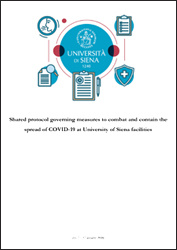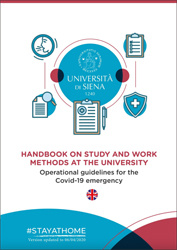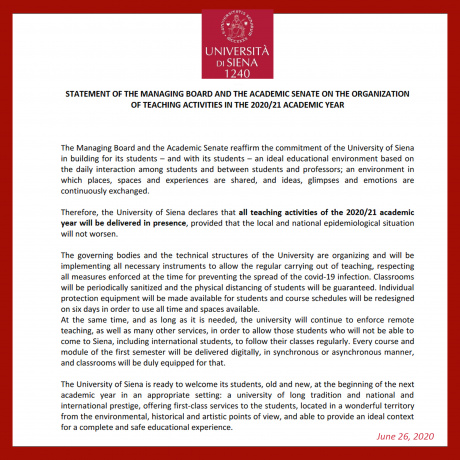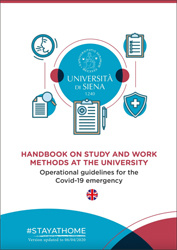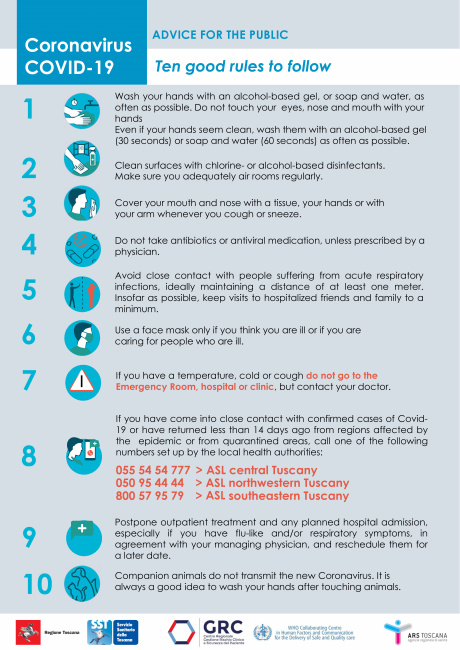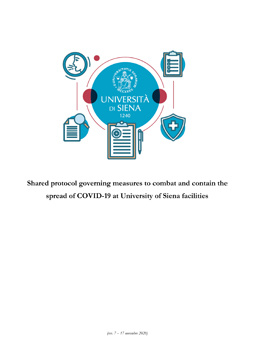University of Siena – Rector
Academic Senate
University of Siena – Rector
University of Siena – Rector
- Message for students
University of Siena
University of Siena – Rector
University of Siena – The Rector
University of Siena
University of Siena – Academic Senate
University of Siena – Managing board and Academic Senate
University of Siena
Unversity of Siena
University of Siena – Academic Senate
University of Siena
University of Siena
- Interruption of teaching activities in USiena - extended to April 13
To compensate for the suspension of training activities and classroom lessons, in compliance with ministerial provisions, the University of Siena has activated online courses.
Lecturers may deliver modules in one of two ways:
- lessons via live streaming using Gmeet
- recorded lectures and course materials uploaded on the Moodle platform
LECTURES IN STREAMING VIA GMEET
To access the lectures that will be broadcast via live streaming using Gmeet, connect to the Unisi page of theprofessor delivering the lectureand click on the link “Lezioni a distanza” ("distance learning").
The lecturer's pages may be accessed from the dedicated platform:
► Docenti (Lezioni a distanza)
TEACHING MATERIALS AND REGISTERING FOR LESSONS
To register for lessons and download course materials, connect and log into the Moodle e-learning platform, select the course module from the list or use the search engine,and register for the module.
The Moodle platform may be accessed using the following link:
WHICH TEACHING METHOD WILL BE ADOPTEDFOR MY COURSE MODULE?
To find out which method the lecturer has adopted for delivering lessons:
- connect to the University Planner platform. You will find information in the lesson timetable
- you will receive information directly from the lecturer
- you will have to connect to the Moodle e-learning platform. You will findinformation within the module information sheet.
Information will gradually become available.
- Interruption of teaching activities in USiena – extended to April 13
What's to know about CORONAVIRUS 2019-nCoV
It is a new coronavirus strain which causes a respiratory disease. The outbreak of coronavirus was identified in Wuhan, in the Chinese province of Hubei. Chinese health authorities reported thousands of cases across the country.
Coronaviruses can infect a number of pets and wild animals. Coronaviruses can be transmitted from animals to humans and then from humans to humans. This had happened, for example, with the viruses causing MERS and SARS.
Data about the coronavirus genomic characterization show that 2019-nCoV is a betacoronavirus and, like MERS and SARs, it may have its origin in bats.
For more information, visit the CDC web site https://www.cdc.gov/coronavirus/index.html.
Please follow the virus outbreak through the official channel of the Ministry of Health.
This webpage provides useful and updated information about the contagion and aims at protecting our community's health.
FAQs about Coronavirus 2019-nCoV outbreak
How does the coronavirus spread?
Human to human contagion mainly happens via respiratory droplets produced when an infected person coughs or sneezes, like how influenza and other respiratory pathogens spread. Similarly, to SARS and MERS, the human to human spread has been confirmed through close contact.
Symptoms
2019-nCoV infections may result in symptoms ranging from mild (80% of cases), to severe (20% of cases) with possible death in a very small proportion of cases (2%). Symptoms may appear from to 2 to 14 days after exposure and include:
- Fever,
- Cough,
- Shortness of breath.
Prevention
The World Health Organization recommends the following hygiene practices and preventive actions (fonte CDC):
- Frequently clean your hands by using alcohol-based hand rub or soap and water;
- When coughing and sneezing cover your mouth and nose with flexed elbow or tissue – throw the tissue away immediately and wash your hands;
- Avoid close contact with anyone who has fever and cough;
- If you have fever, cough and difficulty breathing seek medical care early and share previous travel history with your health care provider.
Is it safe for staff members and students to travel to China?
Italian Government has decided to temporarily avoid traveling to China until further notice.
The reason for this alert resides not only in the 2019-nCoV infection risk, but also in the unpredictable nature of the outbreak. Indeed, there is a connected risk of social disorders in the outbreak-affected areas which could make the return journey impossible.
Recommendation for students and staff members coming back from China
If you are experiencing some of the symptoms (fever, cough, shortness of breath) you should:
- immediately see a doctor or call the toll-free telephone 1500 of the Italian Ministry of Health.
- Avoid close contacts with other people and do not go to crowded places;
- Students are recommended not to attend classes or other activities if they are experiencing some symptoms.
If you are not experiencing any of the symptoms:
- Monitor your body temperature every day
- In case of an increased body temperature should immediately see a doctor or call the toll-free telephone 1500 of the Italian Ministry of Health.
Students with no symptoms may participate to activities and classes with no limitations and without the need to wear a mask.
Recommendation for visiting scholars, researchers and staff members from China
Chinese visitors should monitor their health status carefully by taking their temperature and watching for other possible symptoms during the first 14 days after leaving from China and should see a doctor in case of illness.
 Ateneo
Ateneo Didattica
Didattica Ricerca
Ricerca Internazionale
Internazionale